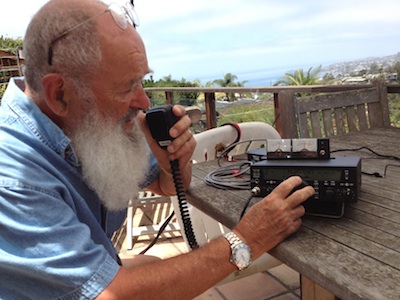By Justin Swanson | LB Indy

“Whiskey. Oscar. One. Sierra. Whiskey. Oscar. One. Sierra. C-Q, C-Q. Standing by. C-Q. Calling and by. Calling and by,” John Kountz, WO1S, utters in the microphone unit attached to his radio, broadcasting and receiving signals from across the world as he seeks a fellow HAM operator to share in the old world information exchange. It is a process wanting of discovery, requiring only serendipity. And the right equipment.
Kountz is the chief radio officer of the Laguna Beach Emergency Communications Team, a group of HAM radio operators in the city who respond to emergencies by providing Laguna police support in their communications. The LBECT is hosting its own “Field Day” Saturday and Sunday, June 22 and 23 from 11 a.m. to 11 a.m. the next day. It is a 24-hour exercise and educational training in the use of emergency communications operations with “off the grid” technology, i.e. solar powered HAM radios. Working out on the access road off Alta Laguna Park, all are invited to the coordinated effort throughout the country with other radio operators tuning in to each other’s frequencies, demonstrating and practicing emergency protocol and the joy of HAM radios. It is part of LBECT’s 15th anniversary.
Kountz has been working with HAM radios for 20 years partly as an extension of his work in electronics firms where he developed a “built-in capability” to use the equipment and understand its mechanics. In 1989, while his interest was burgeoning, Kountz acquired a huge radio teletype interceptor, a Stepper Three Element Yagi, that stands some 20 to 30 feet above his house in his backyard. He began intercepting a Russian surrogate for Afghan radio and compiled “a database of political and sundry aspects of the country” until the early 2000s.
Now, of course, he runs the LBECT, a vital organization as he finds it.
“What happens when telephone or cell phones go bad and you still want to call home?” he asks. “If you want to communicate and be sure you can communicate, HAM radio is the way to go.”
In the event of, most likely, a natural disaster knocking out communication lines, LBPD would activate the LBECT, and, with their assistance, be able to contact and coordinate police and fire squads and contact other agencies, says Sergeant George Ramos.
That is why, Kountz says, it is important to maintain a schedule of practice, opening lines, or signals rather, of communication with others so that, in the event of an emergency, one would be able to make contact with others. Kountz and some of the other 105 licensed amateurs make a point to radio one another, holding regular drills Tuesdays on 145.510 mhz on the FM frequency.
Kountz demonstrates the efficiency of his operations; he builds his Special Buddipole Shockcord Dipole on his front porch in less than 15 minutes. It stands somewhere between 10 and 15 feet with a larger antenna extension. Powered by solar panels, the radio is hooked up and Kountz can send and receive signals from around the world. The signal has a wavelength so long it “knife-edges” over hills, such as those in Laguna.
Getting a hold of someone is another matter. Without a schedule kept, Kountz extemporizes and explains that there are three dimensions to radio communication: time, frequency, and propagation.
“When propagation is good, the sky is the limit for communicating,” he says.
The whole process is a bit like fishing, he admits. Watching him perform his calls for others, it seems an apt comparison. One throws out a line and waits. It requires patience. One tries other frequencies. It requires persistence. One goes through a routine, a kind of protocol that is repeated calling out in radio signals repetitively and keenly. It requires a dedication to form.
The LBECT was resurrected in 1998 and received City Council approval the next year, handed off to a division of the police department. They were activated during the Sept. 11, 2001 attacks and too for the Flamingo road slide in 2005. They participate in Patriot’s Day organization and the Pacific Coast Triathlon as radio backup echoing messages and receiving commands. Kountz calls them a walking radio station. Their job is to observe and report. They do not originate information, but rather relay it when it is there and needs to be.
The LBECT can also provide info for study material for those who wish to pass the FCC examination and become an amateur HAM radio operator.





Great article! One correction: it’s “ham”, not “HAM”. It’s not an acronym.
A thorough explanation of the name is on this Wikipedia page:
http://en.wikipedia.org/wiki/Etymology_of_ham_radio